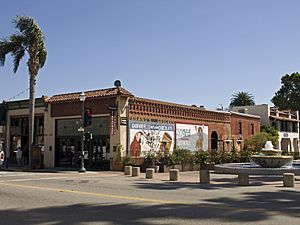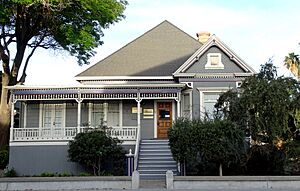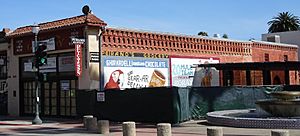Peirano Market facts for kids
Quick facts for kids Peirano Market |
|
|---|---|

Peirano Market in 2014
|
|
| Location | 204 East Main Street, Ventura, California |
| Built | 1877 |
The Peirano Market is a special old building in Ventura, California. It's also known as Peirano's Grocery or Peirano Store. This red brick building was built way back in 1877. It has cool decorative brickwork and a unique roof with Spanish-style tiles.
For over 100 years, from the 1880s to the 1980s, the Peirano family ran a general store and then a grocery store here. The building became a City of Ventura Historic Landmark in 1978. Later, in 1991, archaeologists found old parts of the San Buenaventura Mission Lavanderia (a laundry area) right underneath the building! This discovery also became a historic landmark. The Peirano Market is an important part of the Mission San Buenaventura Historic District.
The building was empty for a long time after the city bought it in 1987. It later housed restaurants from 1998 to 2016. In 2022, the Peirano Market reopened as a market and delicatessen, bringing its history back to life.
Contents
Building History and Early Owners
Building the Market in 1877
A builder named J. J. Mahoney constructed the Peirano Market building in 1877. Mahoney was a well-known builder in Ventura during that time.
The first person to rent the building was Alex Gandolfo, an immigrant from Italy. He opened a store that sold many different things, like groceries and other goods. Gandolfo was one of many Italian immigrants who came to Ventura in the 1870s.
Nick Peirano Sr. Takes Over
In the early 1880s, Nick Peirano Sr. came to Ventura from Genoa, Italy. He was Alex Gandolfo's nephew. Nick Sr. worked in Gandolfo's store and eventually took over the business around 1888 when Gandolfo left town. In those early days, the store sold everything from food to farm tools, wine, and even shotgun shells!
Nick Sr. married Clara Raffetto, who was also an Italian immigrant, in 1897. They had six children and lived in a beautiful Queen Anne style house nearby.
The Peirano Brothers' Store
In 1931, Nick Sr.'s sons, Nick Jr. and Victor, took over the family business. They changed the store to focus more on groceries, especially Italian foods. They sold many kinds of pasta, salami, aged cheeses, and imported canned goods. People would travel from far away just to buy their special Italian groceries!
Nick Sr. passed away in 1937. Victor continued to live in the family home with his mother. After Victor died in 1965, Nick Jr. ran the store by himself.
A Glimpse into the Past
Even as big supermarkets opened, Nick Jr. kept the Peirano Market much the same. He liked that it didn't change, saying, "That was what was so unique about our store." It felt like stepping back in time. The store had wallpaper from the early 1900s, original wooden floors, and old-fashioned items like sacks of beans. It was decorated with antique cans, bottles, and a large kerosene lamp. There was even an old grandfather's clock that Nick Sr. received in 1904!
In 1978, the City of Ventura recognized the store as a historic landmark. Nick Jr. retired and closed the market in July 1986.
City Takes Ownership and New Discoveries
Murals and City Purchase
In 1986, an art teacher named Linda Lorr painted large murals on the outside wall of the building. These murals looked like old advertisements for products like Ghirardelli chocolate and Borax. Nick Jr. remembered that his father used to have new ads painted on that wall every year.
In 1987, the City of Ventura bought the building. They hoped to find someone to use it, but fixing the building to be safe from earthquakes was very expensive.
Uncovering the Mission Lavanderia
In 1991, archaeologists dug under the Peirano's store. They made an amazing discovery: the remains of the San Buenaventura Mission Lavanderia! This Lavanderia was a special place where the Chumash people who lived at the Mission would wash clothes. It also helped direct water to the Mission gardens.
The archaeologists found a central tank for water, along with drains and channels that carried water. They also found many old items like pottery, glass bottles, and even Chinese artifacts. This discovery showed how much history was hidden beneath the building!
Later Years and Reopening
Empty Building and Fire
After the archaeological discovery, the building stayed empty for over 10 years. There was a lot of discussion about whether to fix it up or tear it down because of the high cost of earthquake repairs. In 1996, a fire broke out in an upstairs storage area, adding to the building's challenges.
Restaurants and New Beginnings
In 1997, a company bought the building and spent a lot of money to fix it. They kept the outside of the building looking original, and they saved the old wooden floors inside. The Lavanderia underneath was protected with steel beams and buried in sand to keep it safe.
In August 1998, a Mediterranean restaurant called Jonathan's at Peirano's opened. Later, it became Peirano's Restaurant and the Red Room. The restaurant closed in January 2016.
After more renovations, the building reopened in 2022 as Peirano's Market & Delicatessen. Today, it continues its long history as a place for the community to gather and enjoy good food.
See also



